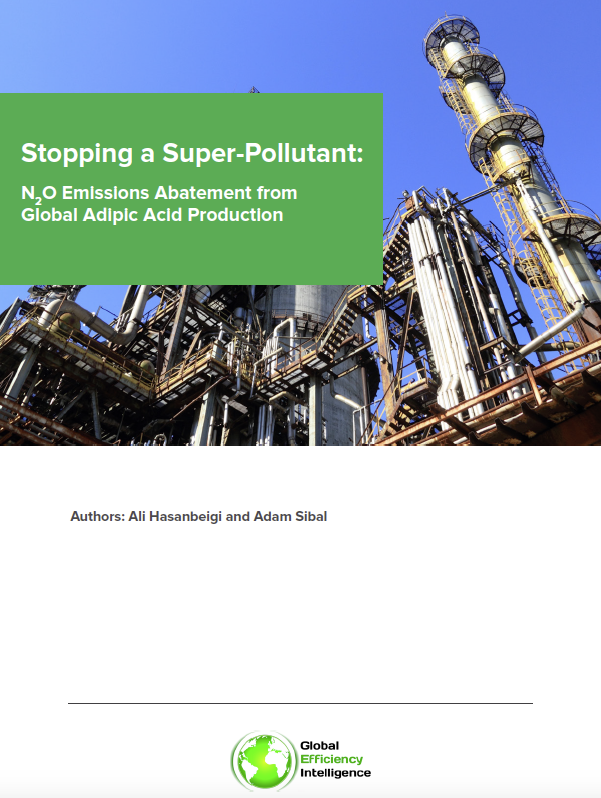Stopping a Super-Pollutant:
N2O Emissions Abatement from Global Adipic Acid Production
Authors: Ali Hasanbeigi and Adam Sibal
Adipic acid is a white, crystalline compound and is primarily used in the production of nylon 6,6. Adipic acid is also used to produce polyurethanes, as a reactant to form plasticizers and lubricant components, and is used in the production of polyester polyols. There are estimated to be 39 operational facilities globally producing adipic acid while almost two thirds of the global adipic acid production takes place in China and U.S. Adipic acid production is one of the largest sources of nitrous oxide (N2O) emissions. The impact of 1 kg of N2O on warming the atmosphere is almost 273 times that of 1 kg of carbon dioxide (CO2). Therefore, N2O is one of the so-called super pollutants.
The annual N2O emissions from adipic acid production facilities in China is estimated to be about 134 million tons (Mt) of CO2eq/yr for 2021 while the rest of the world is estimated to contribute just 8.5 Mt CO2eq/yr. China accounts for 94% of global annual N2O emissions from adipic acid production. Thus, ensuring the N2O abatement technologies are installed and operating in all adipic acid production plants in the China should be considered a priority in this industrial sector. There are widely used commercially mature technologies to reduce N2O emissions at a low cost. Our analyses indicate that adipic acid emissions reductions are highly cost effective, with high-level controls available at less than $0.50 per ton of CO2eq abated, and ultra-high levels of control at less than $5 per ton of CO2eq abated.
Adipic acid intermediary products include nylon 6,6, polyurethane, adipate ester, and other products. Nylon 6,6 is by far the most significant product produced from adipic acid with a share of over 83% (over 2,500 kilotons per year (kt/yr)) and polyurethane is the second largest product with a share of over 8% (over 230 kt/yr) of total adipic acid demand globally (Figure 1).
Figure 1. Share of adipic acid consumed in downstream intermediary industries (left); Share of nylon 6,6 consumed in downstream industries (right)
The automotive industry consumes about 65% of nylon 6,6 while the bedding mattress segment consumes about 40% of polyurethane. Based on our analysis, the global embodied N2O emissions from the source of adipic acid consumption for nylon 6,6 and polyurethane production were about 112 and 10.5 Mt CO2eq in 2021, respectively.
The passenger cars and light vehicles industry sector may have the largest leverage for the installation of the N2O abatement technologies in its upstream processes. Our analysis estimates that a passenger car or light vehicle has an average embodied N2O emissions of 976 kg CO2eq/vehicle, just shy of 1 tonne CO2eq per vehicle . About 99% of the source of N2O emissions embodied in passenger cars and light vehicles is estimated to be from nylon 6,6 production and the remaining is the source of polyurethane. Out of the 74 Mt CO2eq/yr N2O emissions embodied in passenger cars and light vehicles, the share of tires, car seats, and airbags are about 20%, 6% and 6%, respectively. The embodied N2O emissions intensities for these products are shown in Chapter 6 of the report. The embodied N2O emissions intensity for an airbag, car seat, and tire is estimated to be 28.7, 14.3, and 9.4 kg CO2eq/product, respectively. Embodied N2O emissions intensity for cable tie and bedding mattresses are estimated to be 0.2 and 6.2 kg CO2eq/product, respectively.
Figure 2. Embodied N2O emissions for the selected consumer products in 2021 (Source: This study)
Figure 3 shows the N2O abatement cost impact on final products if the cost of N2O emissions abatement were to increase the price of adipic acid and associated intermediary products (i.e. nylon 6,6 and polyurethane). In terms of the abatement cost per unit of product, the average abatement cost for a passenger car or light vehicle is just $0.4 per vehicle. The abatement cost for airbags, car seats, and tires is estimated to be $0.012, $0.006, and $0.004 per product, respectively. The abatement cost for cable ties and bedding mattresses are estimated to be $0.00007 and $0.0026 per product, respectively.
Figure 3. N2O abatement cost impact on the selected final products (Source: This study)
In this study, we also forecasted the total N2O emissions of the global adipic acid industry up to 2050 under different scenarios by applying varying adoption rates for abatement technologies. In the business-as-usual (BAU) scenario, total N2O emissions of the global adipic acid industry will increase by about 92% between 2021 and 2050. Under the Advanced scenario, our analysis shows that higher deployment of single and dual abatement technologies will result in significant abatement rates for the global adipic acid industry resulting in the estimated annual N2O emissions reductions by 90% and 94% up to 2035 and 2050. If we assume half of Chinese adipic acid plants are running N2O abatement technologies, then the 2021 emissions starting point would be lower.
In summary, reducing N2O emissions from adipic acid production is relatively easy and cost-effective, and the technology is already available and widely used. With the right set of policies and partnerships between industry, policymakers, and other stakeholders, the global adipic acid manufacturing industry can move towards net-zero N2O emissions from the adipic acid production at a very low cost. Global car manufacturing companies can play a significant role in providing the demand pull for this zero N2O emissions adipic acid production.
To read the full report and see complete results and analysis of this new study, Download the full report from the link above.
Don't forget to Follow us on LinkedIn, Facebook, and Twitter to get the latest about our new blog posts, projects, and publications.




